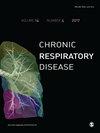慢性阻塞性肺病急性加重期疼痛和呼吸困难的伴随评估;疼痛是一个研究不足的因素吗?
IF 3.5
3区 医学
Q2 RESPIRATORY SYSTEM
引用次数: 1
摘要
呼吸困难是慢性阻塞性肺病(COPD)的一个突出症状,是呼气流量限制的结果,可能导致不同程度的动态高充气、低氧血症、高碳酸血症和神经机械分离。尽管疼痛似乎是COPD患者的常见症状,但在该疾病的临床实践指南中很少考虑疼痛,这可能是由于疼痛是COPD中一个复杂且研究不足的因素。与其他疾病(糖尿病、心脏病和关节炎)相比,COPD患者的疼痛患病率和强度增加,仅次于关节炎患者。与健康个体相比,有几个潜在的机制可能导致COPD患者的疼痛患病率更高。其中包括呼吸肌负荷增加和持续,以及全身炎症、肌肉骨骼疾病和合并症。在稳定期COPD患者中,疼痛是一种普遍的症状,会对生活质量产生负面影响,并与更高水平的肺部过度充气和呼吸困难有关。当呼吸系统症状急性恶化需要额外治疗时,就会发生COPD急性加重(AECOPD)。因此,考虑到这两种感知之间的关系,在AECOPD期间,许多与稳定状态下的疼痛相关的因素往往会恶化。Clarke等人的系统综述侧重于AECOPD患者入院时同时经历的疼痛和呼吸困难的患病率。从最初的数据库搜索中总共发现了1300篇文章,但只有四项研究符合纳入标准并被纳入审查。疼痛和呼吸困难都是令人不快的感觉,具有许多临床、生理和心理特征。脑成像研究强调,对疼痛和呼吸困难的感知激活了大脑中类似的皮层区域,并共享共同的神经机制。由于这些共性,本综述旨在进一步了解疼痛和呼吸困难之间的相互作用,以及它们在AECOPD期间的临床意义。在现有数据中,疼痛和呼吸困难的合并患病率分别为44%和91%,表明这两种症状在COPD患者急性加重期普遍存在。然而,由于报告疼痛和呼吸困难的研究数量较少,因此在AECOPD期间得出这两种症状的临床关联和影响的审查范围有限。正如作者在综述中所描述的,COPD恶化的管理主要集中在缓解呼吸困难、减少药物和氧气需求、恢复基线功能和随访护理。出院护理包已被证明可以减少AECOPD住院后的再次入院,但不能提高生存率或生活质量。放电束的各个组成部分往往各不相同,目前尚不清楚在教育和自我管理计划中是否考虑了疼痛。正如Clarke等人所强调的,这可能是由于对加重期疼痛的认识不足和研究不足,限制了本文章由计算机程序翻译,如有差异,请以英文原文为准。
The concomitant assessment of pain and dyspnea in acute exacerbations of chronic obstructive pulmonary disease; is pain an understudied factor?
Dyspnea is a prominent symptom of Chronic Obstructive Pulmonary Disease (COPD), occurring as a result of expiratory flow limitation, which may lead to varying degrees of dynamic hyperinflation, hypoxemia, hypercapnia and neuromechanical dissociation. Although pain appears to be a prevalent symptom in COPD patients, it is rarely considered in clinical practice guidelines for the management of the disease, which could be due to pain being a complex and understudied factor in COPD. When compared to other disease entities (diabetes, heart disease and arthritis), COPD patients had an increased risk of pain prevalence and intensity, second only to those with arthritis. There are several underlying mechanisms that may contribute to higher pain prevalence in COPD compared to healthy individuals. These include increased and persistent respiratory muscle loading, along with systemic inflammation, musculoskeletal disorders and co-morbities. In patients with stable COPD, pain is a prevalent symptom which negatively impacts quality of life, and is associated with higher levels of lung hyperinflation and dyspnea. An acute exacerbation of COPD (AECOPD) occurs when there is an acute worsening of respiratory symptoms requiring additional treatment. Thus, given the relationship between the two perceptions, many factors linked to pain in the stable state tend to worsen during an AECOPD. The systematic review by Clarke et al. focused on the prevalence of pain and dyspnea experienced concurrently in people admitted to hospital with an AECOPD. A total of 1300 articles were identified from initial database searches, however only four studies met the inclusion criteria and were included in the review. Pain and dyspnea are both unpleasant sensations which share many clinical, physiological and psychological features. Brain imaging studies highlight that perceptions of pain and dyspnea activate similar cortical regions of the brain, and share common neural mechanisms. Due to these commonalities, the review aimed to further understand the interactions between pain and dyspnea, and their clinical implications during an AECOPD. Of the available data, pooled prevalence of pain and dyspnea was 44% and 91% respectively, demonstrating that both symptoms are prevalent in COPD patients during acute exacerbations. However, due to the small number of studies co-reporting pain and dyspnea, the scope of the review to draw clinical associations and implications of both symptoms during AECOPD was limited. As described by the authors in the review, management of COPD exacerbations primarily focuses on relieving dyspnea, reducing medication and oxygen requirements, returning to baseline function and follow up care. Discharge care bundles have been shown to reduce hospital readmissions following hospitalisation for an AECOPD, but did not improve survival or quality of life. The individual components of discharge bundles tend to vary and it is not clear whether pain is considered within the education and self-management plans. This is likely due to pain during exacerbations being under recognised and under researched, as highlighted by Clarke et al., limiting the
求助全文
通过发布文献求助,成功后即可免费获取论文全文。
去求助
来源期刊

Chronic Respiratory Disease
RESPIRATORY SYSTEM-
CiteScore
5.90
自引率
7.30%
发文量
47
审稿时长
11 weeks
期刊介绍:
Chronic Respiratory Disease is a peer-reviewed, open access, scholarly journal, created in response to the rising incidence of chronic respiratory diseases worldwide. It publishes high quality research papers and original articles that have immediate relevance to clinical practice and its multi-disciplinary perspective reflects the nature of modern treatment. The journal provides a high quality, multi-disciplinary focus for the publication of original papers, reviews and commentary in the broad area of chronic respiratory disease, particularly its treatment and management.
 求助内容:
求助内容: 应助结果提醒方式:
应助结果提醒方式:


